- Home
- Naguib Mahfouz
The Quarter Page 2
The Quarter Read online
Page 2
The first episode of the series of articles, Awlad Haratina, appeared in the Cairene newspaper Al-Ahram in September 1959. Bearing in mind the instantaneous success that the volumes of Mahfouz’s Trilogy, published just two years earlier, had enjoyed, it is not a little surprising that there was no announcement and no fanfare; the article simply begins with the title and the name of its author, Naguib Mahfouz. That said, it did not take long for readers to read between the lines and discover that this particular hara has its own maximally symbolic connotations, as the figure of Adham carefully replicates incidents in the life of the Biblical Adam, culminating in his expulsion from Eden. The quarter in the title of Awlad Haratina, it emerges, is portrayed by the novel’s narrator, basing his narrative on the accounts of traditional bards, as the residence of successive generations of humans. Periods dominated by the benign influence of religious leaders (figures representing Moses, Jesus, Muhammad and ‘Scientia’) are interspersed with depictions of the violence of the quarter’s gangs and against the continuing presence outside the quarter of the house of the mysterious figure of Jabalawi, who had originally ejected Adham for his disobedience.
The symbolic resonance of this continuing weekly series did not escape the notice of Al-Azhar, the major institution of Muslim Sunni scholarship and learning in Cairo, who vigorously objected to its continuing publication. Despite their protests, the editor of Al-Ahram, Muhammad Hasanayn Haykal, refused to stop publication. However, when the series was completed (and its original version is still available on the archived pages of the newspaper), Mahfouz agreed with the authorities of Al-Azhar that it would never be published in book form in Egypt during his lifetime. However, in 1967 a book version of Awlad Haratina was published in Beirut, without Mahfouz’s knowledge or permission.
I provide these details here because the institution of the hara, used in this highly symbolic fashion, was to become a frequent resort for Mahfouz in his subsequently published works, and, I would add, is clearly present in this new collection of eighteen narratives. It was in the 1970s, after a decade in which Mahfouz had produced an amazing number of fictional works – novels and short stories – characterised by an increasingly allusive and economical style, that he returned to the hara as a particular locus for his fictions. While Hikayat Haratina (1975; Fountain and Tomb, 1988), for example – with its seventy-eight tales set in 1920s Cairo and its concern for the lives of its quarter’s inhabitants in a time of profound change, constitutes a clear precedent to the spatial context of these recently discovered narratives, it is Mahfouz’s Asda’ al-Sira al-Dhatiyya (1994; Echoes of an Autobiography, 1997) that, for a number of reasons, can be seen as having a direct relationship with them. Like Awlad Haratina, Asda’ al-Sira al-Dhatiyya was first published in serialised form in Al-Ahram: 211 short narratives that appeared in the Friday edition of the newspaper between February and April 1994. The appearance of this lengthy series of articles, published initially during what was to prove to be a very significant time period – just a few months before Mahfouz was viciously attacked, and the addition of a note to the manuscript of these newly discovered narratives, stating ‘To be published in 1994’, lend a considerable significance to the apparent temporal juxtaposition of the two sets of texts and to the questions that I have raised above about both the timing and generic purpose of this new set.
Briefly stated, Asda’ al-Sira al-Dhatiyya consists of a large collection of short, numbered texts which can be conveniently divided into two: in the first part, a narrator reminisces about days of yore and recalls incidents in his life and people whom he knew; in the second part (beginning with text no. 112) the reader is introduced to the figure of Sheikh Abd Rabbih al-Ta’ih (servant of his Lord, the wanderer), who dispenses homiletic wisdom to his listeners – for example, ‘the only thing more stupid than a stupid believer is a stupid infidel,’ and ‘the most powerful people of all are those who forgive.’
In the eighteen texts collected in this volume, we are again dealing with a series of short narratives, each with its own title. The hara is the location of all the differently titled segments, but, as is the case with the other works that I have just mentioned, that location also assumes a broader and more symbolic function as the site of a sample of human society, with all its foibles, conflicts, relationships, triumphs and defeats. Two key figures have varying roles to play in each of the narratives: the first is the shaykh al-hara, the administrative head of the quarter; the second is the imam, the religious figure who supervises the local zawiya, a combination of a mosque, Qur’an school and fountain, and serves as a regular counsellor to the shaykh al-hara. In these narratives the two authority figures find themselves constantly at the centre of whatever actions are provoked by the quarter’s inhabitants, whether they reside there or, as happens in some of the narratives, have returned after prolonged absences. Apart from the quarter and its centrally located mosque, there is one other location that is the focus of several of the narratives, the qabw near the old fort, which I have translated as ‘cellar’. The people who either reside there or come to visit have an encounter with the unseen and unknown, a clear reflection of another of Mahfouz’s ongoing interests throughout his career, that of Sufism and its frequent invocation of the twin concepts of al-zahir (the evident) and albatin (the interior, hidden). In these narratives, those who have such encounters inside the cellar emerge from the experience with their perspectives changed, often requiring and provoking a confrontation with the authority figures in the quarter. These narratives then, like the others that we have discussed above, reveal the continuing craft of an author who uses a community and location of limited dimensions as a symbol to point to issues of more universal significance.
In talking about Mahfouz’s techniques earlier, I alluded to his clear move to a more allusive and economical style, one that becomes even more so in his work of the 1990s. Mahfouz was fully conscious of the changes that he was undertaking. In a telephone conversation with me in 1971, he specifically drew my attention to a completely new mode of writing, as he termed it, that he was adopting for his series of vignettes, Al-Maraya. Unlike the ‘quarter novels’ of the 1940s, there is minimal description of place in these eighteen narratives; one would be hard pressed to use them as a basis for drawing a map of this particular ‘quarter’. The reader is taken straight into the core of the narrative, with no preliminaries and few, if any, of the conventions of a genre such as the short story. Conversations, often involving confrontations and challenges to traditional norms, are plentiful, as inhabitants find themselves having to deal with unfamiliar situations and to resolve familial and social problems that fate and the forces of the unseen have thrown in their path.
While I have previously translated five of Mahfouz’s novels and a collection of his short stories (up to 1970), it has proved a pleasant challenge for me to render into English the style and structure of the later Mahfouz reflected in these eighteen narratives. The decisions necessarily involved in that process of translation have led me inexorably to the conclusion that this recently discovered manuscript is a reflection of his later creative expressions involving the symbolic function of the hara rather than earlier phases in his long career as a writer. In the end, however, we are left with an unanswered (and probably unanswerable) question: since these eighteen narratives show a distinct unity of location, purpose and style, are they a complete work or merely part of what was to be a larger project that was begun but never completed? It is perhaps only appropriate that we are left with a mystery. Meanwhile, we are without a doubt grateful for this unexpected gift.
THE QUARTER
THE OVEN
The disaster had happened. Ayousha had run off with Zeinhum, the baker’s boy. When the news broke, fragments scattered all over the quarter. Down every alleyway, at least one good heart expressed disbelief.
‘God help us all! What a disaster for you, Amm Jumaa, you are a good man!’
The Amm Jumaa in question was Ayousha’s father. Head of th
e family, he was the father of five strapping lads. Ayousha, his only daughter, was now fated to knock him off his pedestal of decency and respect.
It was only after the scandal blew up that anyone had anything to say about her. She was said to be beautiful and charming. Umm Radi, who sold spice-paste, declared:
‘She’s beautiful; there’s no denying that. But she’s too bold. Glances from those flashing eyes of hers go straight into the heart of the person she’s talking to, so they forget what they’re talking about.’
Amm Jumaa and his sons were devastated and simply stared at the ground. At first, they were so angry that they took to spreading out across the quarter, searching and listening for information. But it was fruitless.
‘Mistakes can lead a person to commit crime,’ the Head of the Quarter eventually told Amm Jumaa. ‘He’s lost whatever happens.’
Amm Jumaa kept a grip on himself on account of his sons.
‘Just tell yourselves your sister’s dead,’ he told them. ‘God will have mercy on her. Leave everything else to Him.’
Everyone put the story together as they saw fit, but it was predictable enough. The girl had met and fallen in love with the boy as he took the dough to the oven and brought home the bread. It would never be possible for the baker’s son to ask for the hand of the daughter of a rich cloth-merchant; the two lovers had decided to run away. Ayousha collected her own jewellery and as much of her mother’s as she could find, and they fled. The only conceivable conclusion to the story was that they would get married, wherever they were.
That was the end of the story of Ayousha and Zeinhum. It took a very long time for the wound in Amm Jumaa’s family to heal. They went back to their normal lives but suffered the usual downward spiral. The merchant went bankrupt and made plans to sell his house.
In the very depths of his misery, a messenger he did not recognise arrived with the money he needed.
‘This money has been sent by your daughter, Ayousha,’ the man said. ‘Divine will has decreed that it is her husband, Zeinhum, who brings it to you.’
The man’s son-in-law informed him that his wife had sold the jewellery she had taken and used it to open a bakery for him. After some hard times, they were now doing well.
‘Do you see?’ the Head of the Quarter told the mosque Imam. ‘The girl’s come back at just the right moment. You have no need to forgive her sin.’
YOUR LOT IN LIFE
We do not know precisely when the phenomenon began to occur. All those who witnessed it have their own version. Time lost its order. Here is what Amm Hifni, the water-seller, had to say:
‘I went to the pastry-seller to buy some honey cakes with extra vegetable fat. He took a roll of dough, flattened it with a rolling pin and smoothed it with the palm of his hand. But just then he stopped what he was doing and burst into tears. I was stunned. I asked him what the matter was and what I could do to help. But he just kept on crying, holding out his hands, wringing them and sobbing again. People gathered in front of his shop until his family arrived and took him home, still crying.’
A woman who sells pickled vegetables said:
‘Sitt Umm Ali came to my stall with a bowl to fill with pickled vegetables. At one moment she was pointing to the cucumbers and falafel, but then she suddenly stopped and her expression froze. She began weeping violently, and, as time went on, it only grew more intense and abundant. I was paralysed from head to toe; I worried I had done something to upset her. People gathered round, and her husband hurried over from his shop and took her home. Everyone looked at each other in shock and amazement.’
The stories kept multiplying and becoming more elaborate. There were many victims, both men and women. When the news reached the Head of the Quarter, he was irate.
‘You people never stop inventing heresies and lies,’ he said.
However, when he saw a guard break down in tears, he soon stopped blaming people and jumping to conclusions.
‘So here’s a new disaster in our quarter,’ he told the mosque Imam. ‘It never has its fill when it comes to generating disasters.’
‘People cure the condition with hot baths and cold drinks,’ the Imam responded.
Umm Haniyya, the bath-attendant, was close by.
‘The only cure for it,’ she interrupted, ‘is a zar exorcism.’
‘Are demons involved in this condition?’ the Imam asked.
‘No one ever cries for no reason,’ she said. ‘The only exception is if someone is touched by demons; in which case, the demon will only leave him if there’s a zar.’
‘I’m not prepared to accept,’ said the Head of the Quarter emphatically, ‘that the entire quarter is touched. However, I’ll raise the matter with the Health Inspector.’
He duly went to see His Excellency the Inspector and told him the whole story.
‘You’re not separating reality from illusion,’ was the Inspector’s comment.
The Head of the Quarter then swore that he had seen the tears for himself; every house was affected. The next morning, the Inspector visited the quarter, accompanied by a guard and a nurse. The people rushed over:
‘Help us, Your Excellency!’ they all shouted.
He stared at them in fury, but his anger turned to amazement when he saw men and women weeping.
‘Is there anything new about your way of life,’ he asked the Head of the Quarter, ‘that might explain this?’
‘No, sir, absolutely nothing new. Our life is the way it is, with all its joys and sorrows.’
The Inspector went from house to house. He toured the entire quarter from one end to the other. He left no shop, café, fountain, Qur’an school or animal trough uninspected; he checked donkeys and mules and stared long and hard at the walls of the old fort and the cellar. He sat down in the Head of the Quarter’s house, exhausted, and gazed off into the distance. Just then, Umm Haniyya’s voice rose from the crowd that had gathered in front of the shop:
‘The zar ritual!’ she yelled. ‘That’s the only cure, Your Excellency.’
‘Shut up, woman!’ the Head of the Quarter yelled back angrily.
The Head of the Quarter expected the Inspector to say something, but he remained silent. He seemed more and more tired. Eventually the Head of the Quarter decided that the Inspector was about to collapse.
Master Hassan, the musician who owned the local cabaret, noticed the same thing. He suggested to the Head of the Quarter that he take the Inspector to his house to relax by the fountain. He would prepare him a cold drink and arrange some fresh flowers. To save them all from any further complications, the Head of the Quarter readily accepted the offer.
So the Inspector went to the musician’s home. People began talking about their tragedies again.
‘I’ll bet you the Inspector will start weeping,’ said one man.
‘He’s a human being,’ the Head of the Quarter responded angrily. ‘Everyone’s susceptible to contagion.’
However, what emerged from the musician’s house was the sounds of a pulsating rhythm, drumbeats and clapping. Someone looked out from the house facing the musician’s home.
‘He’s dancing!’ the man shouted. ‘And what a dance it is!’
He heard the voice singing:
‘Your lot in life is bound to find you …’
It seems he kept on dancing and singing.
People now thronged from every quarter and responded to the musician’s poem.
All of a sudden, the people who were weeping stopped.
They all dissolved into laughter.
PURSUIT
Zakiyya came back to the quarter after a year away, with a nursing baby in her arms. No one had realised she had left or that she had come back. She still looked skinny and pale; indeed, she was barely there. The blush of beauty on her face had faded, leaving only traces of a long-departed youth. She kept looking at the three houses she had worked in as a servant, after the death of her mother Sukaina, the washer-woman. Eventually she stared hard at the last hous
e, in the direction of the cellar. This was the home of Boss Uthman, who sold canes and umbrellas.
Zakiyya was so poor she could not afford to waste any time. She therefore decided to work as an unofficial vendor of children’s sweets, such as Turkish delight and sugared caraway seeds. In one hand she would hold a basket full of halva squares and in the other she clutched her baby. She began to move from place to place, hawking her halva, but it seemed she was making a special point of standing in front of Boss Uthman’s shop. She made sure that he could hear her voice or see her in person. He could not ignore her forever. When the place was empty, he saw his chance and signalled to her. When she came over, they exchanged looks, hers strong and steady, his deceptive.
‘How are you, Zakiyya?’ he asked.
‘Praise be to God, in any event,’ she responded gruffly.
‘Do you need anything?’
‘God is the great provider,’ she replied boldly, ‘but this baby needs his due, as decreed by God.’
‘That’s a long statement with no meaning. Just say that you’re in need.’
‘I said just what I mean,’ she retorted angrily, ‘and you in particular should understand.’
‘I don’t understand anything!’ he shouted nervously. ‘Get away from me. This is the reward for someone who takes pity on the undeserving.’
He disappeared inside, quivering with anger. She resumed her trade around the shop or nearby, never wavering from her plan. Hour after hour, she would be there, patient and determined. Meanwhile, he was shaking with fury, beset by all kinds of bloody dreams.

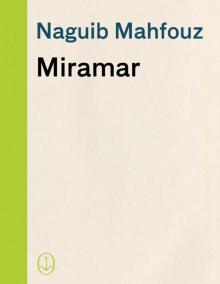 Miramar
Miramar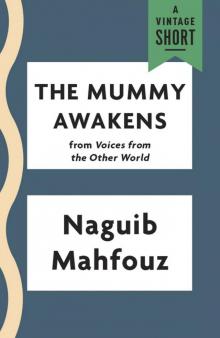 The Mummy Awakens
The Mummy Awakens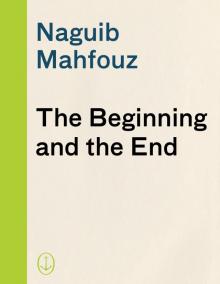 The Beginning and the End
The Beginning and the End Respected Sir, Wedding Song, the Search
Respected Sir, Wedding Song, the Search The Mirage
The Mirage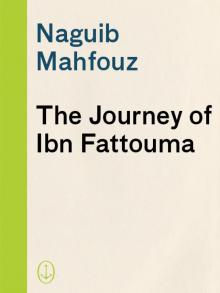 Novels by Naguib Mahfouz
Novels by Naguib Mahfouz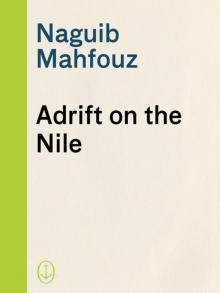 Adrift on the Nile
Adrift on the Nile Karnak Café
Karnak Café Heart of the Night
Heart of the Night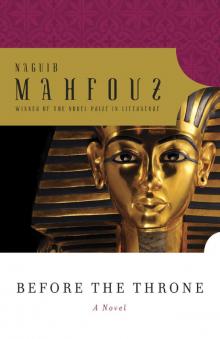 Before the Throne
Before the Throne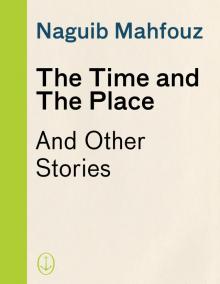 The Time and the Place: And Other Stories
The Time and the Place: And Other Stories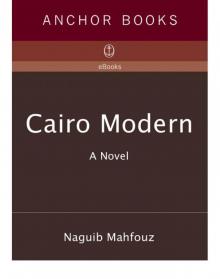 Cairo Modern
Cairo Modern Arabian Nights and Days
Arabian Nights and Days The Day the Leader Was Killed
The Day the Leader Was Killed Morning and Evening Talk
Morning and Evening Talk Three Novels of Ancient Egypt Khufu's Wisdom
Three Novels of Ancient Egypt Khufu's Wisdom Akhenaten: Dweller in Truth
Akhenaten: Dweller in Truth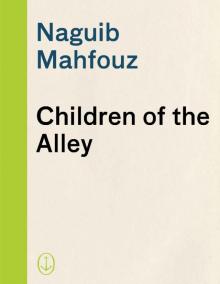 Children of the Alley
Children of the Alley Voices From the Other World
Voices From the Other World The Harafish
The Harafish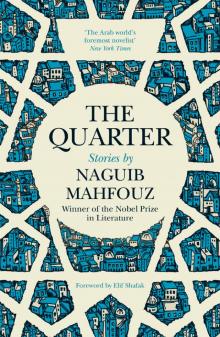 The Quarter
The Quarter The Seventh Heaven: Supernatural Tales
The Seventh Heaven: Supernatural Tales The Cairo Trilogy: Palace Walk, Palace of Desire, Sugar Street
The Cairo Trilogy: Palace Walk, Palace of Desire, Sugar Street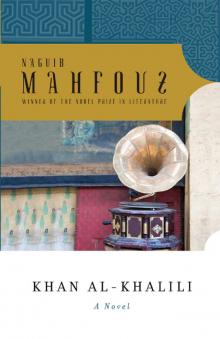 Khan Al-Khalili
Khan Al-Khalili Three Novels of Ancient Egypt Khufu's Wisdom, Rhadopis of Nubia, Thebes at War
Three Novels of Ancient Egypt Khufu's Wisdom, Rhadopis of Nubia, Thebes at War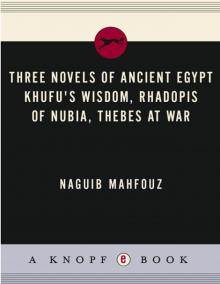 Three Novels of Ancient Egypt
Three Novels of Ancient Egypt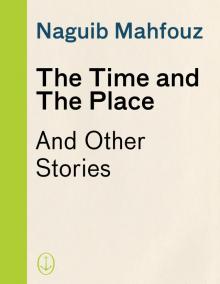 The Time and the Place
The Time and the Place Palace Walk tct-1
Palace Walk tct-1 Akhenaten
Akhenaten The Seventh Heaven
The Seventh Heaven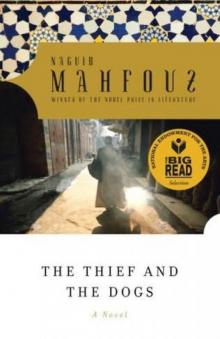 The Thief and the Dogs
The Thief and the Dogs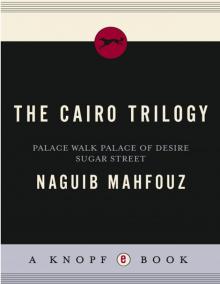 The Cairo Trilogy
The Cairo Trilogy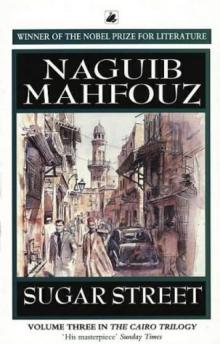 Sugar Street tct-3
Sugar Street tct-3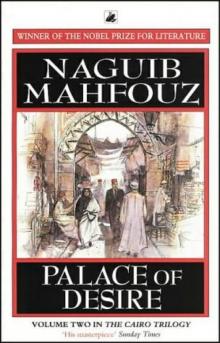 Palace of Desire tct-2
Palace of Desire tct-2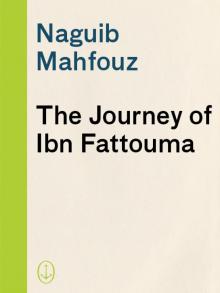 The Journey of Ibn Fattouma
The Journey of Ibn Fattouma